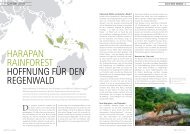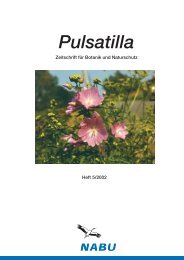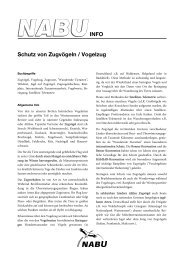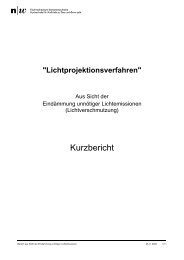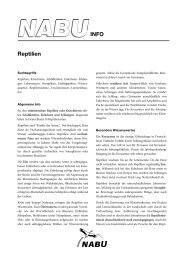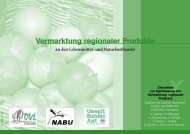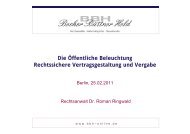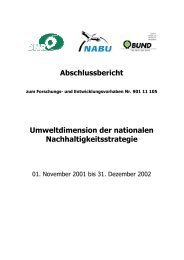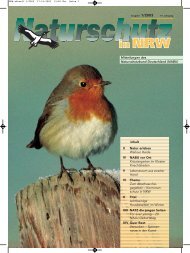Studie "The GMO-emperor has no clothes" (engl.) - Nabu
Studie "The GMO-emperor has no clothes" (engl.) - Nabu
Studie "The GMO-emperor has no clothes" (engl.) - Nabu
Create successful ePaper yourself
Turn your PDF publications into a flip-book with our unique Google optimized e-Paper software.
Nutraceuticals Journal, 2011, 4, 3-11)<br />
Evidence of allergies in animal trials: GE<br />
potatoes caused immune systems of rats to<br />
respond more slowly; GE peas provoked<br />
inflammatory response in mice, suggesting that<br />
they might cause deadly allergic reactions in<br />
people. (Ibid)<br />
Bt toxins have killed many species of insect<br />
larvae. (Ibid)<br />
<strong>The</strong>re have been reports of thousands<br />
of Indian farmers experiencing allergic<br />
reactions after picking Bt cotton. Thousands<br />
of sheep deaths have been reported in AP<br />
after the sheep grazed on Bt cotton. (http://<br />
www.gmwatch.org/latest-listing/1-newsitems/10585-why-gm-crops-are-dangerous<br />
)<br />
A 2001 CDC study found 28 subjects had<br />
experienced apparent allergic reactions after<br />
ingesting GM corn. (CDC report to FDA.<br />
Investigation of human illness associated<br />
with potential exposure to Cry9c. June 11,<br />
2001. Available at: http://www.cdc.gov/nceh/ehhe/<br />
cry9creport/pdfs/cry9creport.pdf ).<br />
4. <strong>The</strong> Myth of Substantial Equivalence<br />
<strong>The</strong> safety debate <strong>has</strong> been repeatedly suppressed<br />
by bad science. One of the unscientific strategies<br />
used to extinguish the safety discussion is to<br />
tautologically define a <strong>no</strong>vel organism or <strong>no</strong>vel<br />
food created through genetic engineering<br />
as ‘substantially equivalent’ to conventional<br />
organisms and foods. However, genetically<br />
engineered crop or food is different because it<br />
<strong>has</strong> genes from unrelated organisms – it can<strong>no</strong>t,<br />
therefore, be treated as equivalent to a <strong>no</strong>ngenetically<br />
engineered crop or food. In fact,<br />
the biotech<strong>no</strong>logy industry itself gives up the<br />
claim of ‘substantial equivalence’ when it claims<br />
patents on <strong>GMO</strong>s on grounds of <strong>no</strong>velty.<br />
While governments and government agencies<br />
promoting genetic engineering refer to ‘sound<br />
science’ as the basis for their decisions, they<br />
are manipulating scientific data and research<br />
to promote the interests of the biotech<strong>no</strong>logy<br />
industry while putting citizen health and<br />
the environment at risk. <strong>The</strong> report by<br />
EPA scientists entitled “Genetic Gene: <strong>The</strong><br />
premature commercial release of genetically<br />
engineered bacteria” and the report by Andrew<br />
Christiansen “Recombinant Bovine Growth<br />
Hormone: Alarming Tests, Unfounded<br />
Approval: <strong>The</strong> Story Behind the Rush to Bring<br />
rBGH to the market” show in detail how<br />
regulatory agencies have been manipulated on<br />
issues of safety.<br />
Scientific agencies have been split and polarized<br />
into two communities – a corporate science<br />
community and a public science community.<br />
<strong>The</strong> corporate science community participates<br />
in distorting and manipulating science. Among<br />
the distortions of corporate science is the<br />
assumption of ‘substantial equivalence’ which is<br />
falsified both by the research done by the public<br />
science community as well as by the intellectual<br />
property rights claims of the biotech<strong>no</strong>logy<br />
industry itself.<br />
When industry wants to avoid risk assessment<br />
and issues of liability, the argument used is<br />
that the genetically engineered organism is<br />
‘substantially equivalent’ to the <strong>no</strong>n-engineered<br />
parent. However, when industry wants property<br />
rights, the same <strong>GMO</strong> becomes ‘<strong>no</strong>vel’<br />
or substantially inequivalent to the parent<br />
organism.<br />
When a safety and intellectual property rights<br />
discourse of the genetic engineering industry is<br />
put side by side what emerges is an unscientific,<br />
incoherent undemocratic structure for total<br />
control through which absolute rights are<br />
claimed and all responsibility is denied and<br />
disclaimed.<br />
This ontological schizophrenia is based on and<br />
leads to incoherence, which is a characteristic of<br />
bad science. Good science is based on coherency.<br />
<strong>The</strong> consistency and incoherence between the<br />
discourse on property rights and the discourse<br />
on issues of safety contributes to undemocratic<br />
structures in which there are <strong>no</strong> mechanisms to<br />
protect citizens from corporate irresponsibility.<br />
A second unscientific concept used to ig<strong>no</strong>re<br />
biosafety considerations is ‘significance’.<br />
Thus the EPA <strong>has</strong> argued that because we are<br />
surrounded by bacteria, the risk of introducing<br />
pathogenic bacteria through gene transfer is <strong>no</strong>t<br />
significant. <strong>The</strong> EPA <strong>has</strong> argued that because the<br />
problem of antibiotic resistance already exists,<br />
any new risk is insignificant. <strong>The</strong>se unscientific<br />
attempts to ig<strong>no</strong>re risks or suppress scientific<br />
data on risks are examples of bad science, <strong>no</strong>t<br />
good science.<br />
A<strong>no</strong>ther strategy used to suppress good science<br />
by bad science is in the design of trials, and the<br />
extrapolation of data from artificially constructed<br />
contexts to real ecosystems.<br />
<strong>The</strong> final strategy used is of direct arm twisting,<br />
used by the US administration repeatedly to<br />
kill the Biosafety protocol in the Convention<br />
of Biological Diversity (CBD), even though<br />
19



